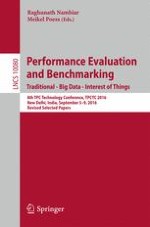2017 | Buch
Performance Evaluation and Benchmarking. Traditional - Big Data - Internet of Things
8th TPC Technology Conference, TPCTC 2016, New Delhi, India, September 5-9, 2016, Revised Selected Papers
herausgegeben von: Raghunath Nambiar, Meikel Poess
Verlag: Springer International Publishing
Buchreihe : Lecture Notes in Computer Science
